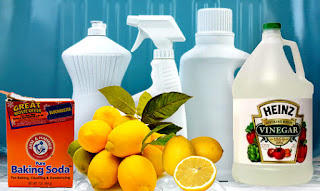10 Simple Spring Cleaning Tips
It is so much more fun to decorate a clean house, which is why I enjoy cleaning and organizing. It’s impossible to put a decorating “bandage” over a messy house. The messes will always glare brighter than a new thrift store candlestick.
Before you do any Spring decorating this year, check out these 10 Simple Spring Cleaning Tips…
1. Formulate A Plan & Set Reasonable Goals
Jot down the areas of your home that you need to clean, come up with a plan and be sure to budget in time for distractions so you won’t get discouraged after just a few hours cleaning. In essence, make a reasonable plan of attack that has at least a 98% chance of being accomplished!
2. Check For Cleaning Supplies
There is nothing more frustrating than to start a project {or Spring cleaning} only to find that you’re out of supplies. I’m on a chemical reduction kick, so when we moved, I got rid of THREE boxes of chemically-laden cleaning supplies. White vinegar, baking soda and Thieves Cleaner are among my favorite household cleaning aids.
3. Involve Your Children {or work while the littles are napping!}
I loved having small tasks to accomplish when I was growing up. Crank up some music and get busy cleaning!
4. Tackle One Area At A Time
It’s exciting to get started cleaning and I sometimes tend to get distracted with various projects throughout the house. But, I’ve found that it’s incredibly helpful and sanity-saving to work on one area at a time. Inadvertently, piles of stuff will migrate to other rooms in your house, but those can be tackled when you get to them.
5. De~clutter Before Cleaning
It is frustrating to be ready to dust an area only to realize that you have to move 15 knick-knacks, 10 pieces of junk mail, broken crayons and wadded up kleenexes before you can get started. Save yourself a headache and get rid of the garbage and extraneous clutter before cleaning!
6. Use Bins To Organize The “Get-Rid-Of” Stuff
Instead of just dividing up things into separate piles that will likely get knocked over or mixed up, use plastic bins to keep them organized. I like having a bin for garage sale items, items to donate, garbage and things that need to be returned to others.
7. Open The Windows For Fresh Air
I love filling my lungs with fresh country air. I can do without the man-ur-e smell, but I love Spring air {minus the pollen, of course}. After being shut up inside for months, it is so refreshing to open the windows and have fresh air flowing through the house.
8. Clean Each Room From Top To Bottom
Let gravity make your job easier by working with it! Start at the ceiling by dusting the ceiling fan or light fixture then get all the “webbys” off the crown molding. Work your way down the walls, over the furniture, all the way to the baseboards and flooring.
9. Change Up Your Accessories For A New Look
I don’t know about you, but I like to change up my accessories a little bit for each season. I’m not talking about redecorating necessarily, but just freshening up things. Since it’s Spring, try switching out heavy, darker items out with lighter and brighter accessories!
10 Design A Daily Cleaning Schedule
After all your hard work is done and your house looks like a magazine cover {not really!}, make sure that you have a good cleaning schedule in place. Whether you need to make one from scratch or update the one you have, set small daily tasks that will help keep your house in order until next Spring…or until you decide to deep clean your house again!

